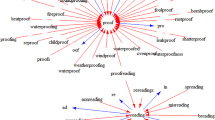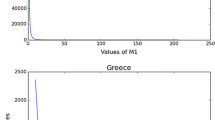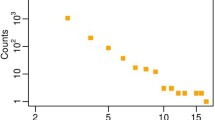Abstract
We propose a model that reflects two important processes in R&D activities of firms, the formation of R&D alliances and the exchange of knowledge as a result of these collaborations. In a data-driven approach, we analyze two large-scale data sets, extracting unique information about 7500 R&D alliances and 5200 patent portfolios of firms. These data are used to calibrate the model parameters for network formation and knowledge exchange. We obtain probabilities for incumbent and newcomer firms to link to other incumbents or newcomers able to reproduce the topology of the empirical R&D network. The position of firms in a knowledge space is obtained from their patents using two different classification schemes, IPC in eight dimensions and ISI-OST-INPI in 35 dimensions. Our dynamics of knowledge exchange assumes that collaborating firms approach each other in knowledge space at a rate μ for an alliance duration τ. Both parameters are obtained in two different ways, by comparing knowledge distances from simulations and empirics and by analyzing the collaboration efficiency \(\mathcal {\hat {C}}_{n}\). This is a new measure that takes in account the effort of firms to maintain concurrent alliances, and is evaluated via extensive computer simulations. We find that R&D alliances have a duration of around two years and that the subsequent knowledge exchange occurs at a very low rate. Hence, a firm’s position in the knowledge space is rather a determinant than a consequence of its R&D alliances. From our data-driven approach we also find model configurations that can be both realistic and optimized with respect to the collaboration efficiency \(\mathcal {\hat {C}}_{n}\). Effective policies, as suggested by our model, would incentivize shorter R&D alliances and higher knowledge exchange rates.










Similar content being viewed by others
Notes
For a more detailed definition and more empirical examples on agents’ activities in collaboration networks, see Tomasello et al. (2014) and its Supplementary Information.
For more information on the International Patent Classification, see http://www.wipo.int/classifications/ipc.
For a rigorous definition of these measures, see Tomasello et al. (2014).
We find that the present network is slightly denser, more clustered, with a shorter average path length than the R&D network analyzed in Tomasello et al. (2014). This happens because we now consider only the firms for which patent data are available, not just any firm reported in the SDC alliance data set. These firms typically have more alliance partners than average, thus making the resulting network more dense and connected.
References
Ahuja G (2000) Collaboration networks, structural holes, and innovation: a longitudinal study. Adm Sci Q 45(3):425–455
Axelrod R (1997) The dissemination of culture. J Confl Resolut 41(2):203–226
Baum J, Cowan R, Jonard N (2010) Network-independent partner selection and the evolution of innovation networks. Manag Sci 56(11):2094–2110
Baum JA, Calabrese T, Silverman BS (2000) Don’t go it alone: alliance network composition and startups’ performance in Canadian biotechnology. Strat Manag J 21(3):267–294
Burt R (1992) Structural holes: the social structure of competition cambridge. Harvard University Press, Massachussets
Cowan R, Jonard N, Ozman M (2004) Knowledge dynamics in a network industry. Technol Forecast Soc Chang 71(5):469–484
Cowan R, Jonard N, Zimmermann J (2007) Bilateral collaboration and the emergence of innovation networks. Manag Sci 53(7):1051–1067
Das T, Teng B (2000) A resource-based theory of strategic alliances. J Manag 26(1):31
Deffuant G, Neau D, Amblard F, Weisbuch G (2000) Mixing beliefs among interacting agents. Adv Complex Syst 3(4):87–98
DeGroot MH (1974) Reaching a consensus. J Am Stat Assoc 69(345):118–121
Fagiolo G, Dosi G (2002) Exploitation, exploration and innovation in a model of endogenous growth with locally interacting agents. LEM Papers Series
Fagiolo G, Dosi G (2003) Exploitation, exploration and innovation in a model of endogenous growth with locally interacting agents. Struct Chang Econ Dyn 14 (3):237–273
Fischer MM, Fröhlich J (2001) Knowledge, complexity and innovation systems. Springer Science & Business Media
Fruchterman T, Reingold E (1991) Graph drawing by force-directed placement. Software- Practice and Experience 21(11):1129–1164
Garas A, Tomasello MV, Schweitzer F (2017) Newcomers vs. incumbents: how firms select their partners for R&D collaborations. arXiv:1403.3298
Gilbert N (2004) Agent-based social simulation: dealing with complexity. Tech. Rep., Center for Research on Social Simulation University of Surrey, Guildford, UK
Gomes-Casseres B, Hagedoorn J, Jaffe A (2006) Do alliances promote knowledge flows? J Financ Econ 80(1):5–33
Grant R, Baden-Fuller C (2004) A knowledge accessing theory of strategic alliances. J Manag Stud 41(1):61–84
Groeber P, Schweitzer F, Press K (2009) How groups can foster consensus: the case of local cultures. Journal of Artificial Societies and Social Simulation 12(2):4
Gulati R, Gargiulo M (1999) Where do interorganizational networks come from? Am J Sociol 104(5):1398–1438
Gulati R, Sytch M, Tatarynowicz A (2012) The rise and fall of small worlds: exploring the dynamics of social structure. Organ Sci 23(2):449–471
Hagedoorn J (2002) Inter-firm R&D partnerships: an overview of major trends and patterns since 1960. Res Policy 31(4):477–492
Hagedoorn J, Link AN, Vonortas NS (2000) Research partnerships. Res Policy 29(4-5):567–586
Hanaki N, Nakajima R, Ogura Y (2010) The dynamics of R&D network in the IT industry. Res Policy 39(3):386–399
Hegselmann R, Krause U (2002) Opinion dynamics and bounded confidence: models, analysis and simulation. Journal of Artificial Societies and Social Simulation 5(3). http://jasss.soc.surrey.ac.uk/5/3/2.html
Inkpen AC, Ross J (2001) Why do some strategic alliances persist beyond their useful life? Calif Manag Rev 44(1):132–148
König MD, Battiston S, Napoletano M, Schweitzer F (2012) The efficiency and stability of R&D networks. Games and Economic Behavior 75(2):694–713
Liebeskind JP (1996) Knowledge, strategy, and the theory of the firm. Strateg Manag J 17:93–109
Mowery D, Oxley J, Silverman B (1998) Technological overlap and interfirm cooperation: implications for the resource-based view of the firm. Res Policy 27 (5):507–523
Owen-Smith J, Powell WW (2004) Knowledge networks as channels and conduits: the effects of spillovers in the Boston biotechnology community. Organ Sci 15(1):5–21
Phelps CC (2010) A longitudinal study of the influence of alliance network structure and composition on firm exploratory innovation. Acad Manag J 53(4):890–913
Podolny JM (1993) A status-based model of market competition. Am J Sociol 98(4):829–872
Powell W, Koput K, Smith-Doerr L (1996) Interorganizational collaboration and the locus of innovation: networks of learning in biotechnology. Adm Sci Q 41 (1):116–145
Powell W, White D, Koput K, Owen-Smith J (2005) Network dynamics and field evolution: the growth of interorganizational collaboration in the life sciences. Am J Sociol 110(4):1132–1205
Pyka A, Fagiolo G (2007) Agent-based modelling: a methodology for neo-schumpeterian economics. Edward Elgar Publishing, chap 29
Raub W, Weesie J (1990) Reputation and efficiency in social interactions: an example of network effects. Am J Sociol 96(3):626
Rosenkopf L, Almeida P (2003) Overcoming local search through alliances and mobility. Manag Sci 49(6):751–766
Rosenkopf L, Nerkar A (2001) Beyond local search: boundary-spanning, exploration, and impact in the optical disk industry. Strat Manag J 22(4):287–306
Rosenkopf L, Padula G (2008) Investigating the microstructure of network evolution: alliance formation in the mobile communications industry. Organ Sci 19 (5):669
Rosenkopf L, Schilling M (2007) Comparing alliance network structure across industries: observations and explanations. Strateg Entrep J 1(3-4):191–209
Sampson RC (2007) R&D Alliances and firm performance: the impact of technological diversity and alliance organization on innovation. Acad Manag J 50 (2):364–386
Schmoch U (2008) Concept of a technology classification for country comparisons. Final report to the world intellectual property organisation (WIPO)
Schweitzer F, Behera L (2009) Nonlinear voter models: the transition from invasion to coexistence. Eur Phys J B Condensed Matter and Complex Systems 67 (3):301–318
Thomson-Reuters (2013) SDC Platinum dataset. http://thomsonreuters.com/sdc-platinum/
Tomasello MV, Burkholz R, Schweitzer F (2017a) Modeling the formation of R&D alliances: an agent-based model with empirical validation. Economics E-Journal, Discussion Papers No. 2017–107, Kiel Institute for the World Economy
Tomasello MV, Napoletano M, Garas A, Schweitzer F (2017b) The rise and fall of R&D networks. Ind Corp Chang 26(4):617–646
Tomasello MV, Perra N, Tessone CJ, Karsai M, Schweitzer F (2014) The role of endogenous and exogenous mechanisms in the formation of R&D networks. Sci Rep 4:5679
Tomasello MV, Tessone CJ, Schweitzer F (2016) A model of dynamic rewiring and knowledge exchange in R&D networks. Adv Complex Syst 19(1–2):1650004
Walker G, Kogut B, Shan W (1997) Social capital, structural holes and the formation of an industry network. Organ Sci 8(2):109–125
Author information
Authors and Affiliations
Corresponding author
Ethics declarations
GV acknowledges support from the Swiss State Secretariat for Education, Research and Innovation (SERI), Grant No. C14.0036 as well as from EU COST Action TD1210 KNOWeSCAPE. M. V. T. acknowledges financial support from the Seed Project SP-RC 01-15 “Performance and resilience of collaboration networks”, granted by the ETH Zurich Risk Center. CJT acknowledges financial support from the University Research Priority Program on Social Network, University of Zurich.
Conflict of interests
The authors declare that they have no conflict of interest.
Rights and permissions
About this article
Cite this article
Vaccario, G., Tomasello, M.V., Tessone, C.J. et al. Quantifying knowledge exchange in R&D networks: a data-driven model. J Evol Econ 28, 461–493 (2018). https://doi.org/10.1007/s00191-018-0569-1
Published:
Issue Date:
DOI: https://doi.org/10.1007/s00191-018-0569-1




